Decades before hot rods, Americans built “gow jobs”
When Dominic Palazzolo’s highboy Ford Model A Roadster rolls into a cars and coffee or a cruise night gathering, he can be pretty sure he’ll have the only “gow job” on the premises. What on earth is a gow job? In brief, it’s a stripped-down high-performance automobile built and equipped as it might have been in the early 1930s. In other words, a prototypical hot rod.
Most of today’s automotive enthusiasts peg the birth of the hot rod in the late ’40s or early ’50s, when returning G.I.s, bursting with pride, energy, and dollars they’d been unable to spend on the battlefield, embraced four-wheel excitement in the form of cars modified to look good and go fast. Quite often, the object of their affection was one of the abundant and inexpensive machines of the ’30s, usually a V-8 Ford Model B, and quite often a roadster. While this performance revolution undoubtedly kicked off the post-war hot-rod craze, it wasn’t the first time America had fallen in love with fast cars. The fathers and grandfathers of the ’50s rodders took a high-speed turn at the wheel as well. And at least for a time, their cars were called gow jobs.
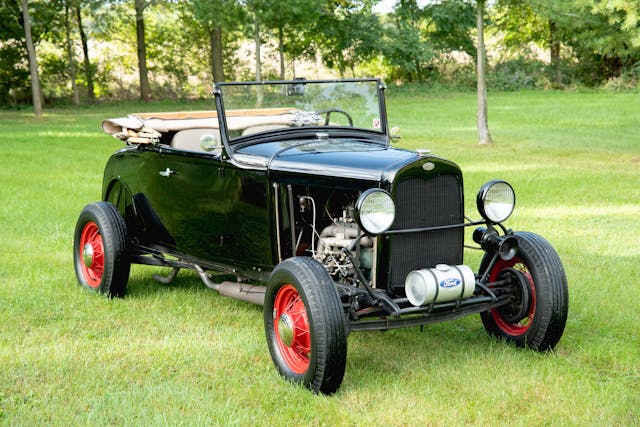
I had never heard of gow jobs until I met Palazzolo at a “Parking at Pasteiners” gathering on Metro Detroit’s Woodward Avenue and did a little research. “Gow,” I learned, was a slang term for opium, in the wild and crazy days of the jazz age. At the time, the drug was used to hop up racehorses. Since the cars of the ’20s were only a generation removed from the horse as a primary means of transportation, gow job was an obvious choice of terminology when it came to describing automobiles modified to perform better than factory-issue vehicles. “Hot rod” was both a term and a notion still far in the future.
The first gow jobs were Ford Model Ts, but the more advanced Model A became the vehicle of choice in the late ’20s. Modified carburetors, higher compression ratios, and larger displacements, along with a variety of other techniques, served to increase the horsepower output of the four-banger engines. Removal of extraneous body parts, like fenders, interior trim, and even windshields made the machines lighter. Roadsters could be driven on the street, yet they were light enough for competition. Some of the most serious racers went even further, creating “speedsters” that were stripped of all sheetmetal save the cowl and cockpit.
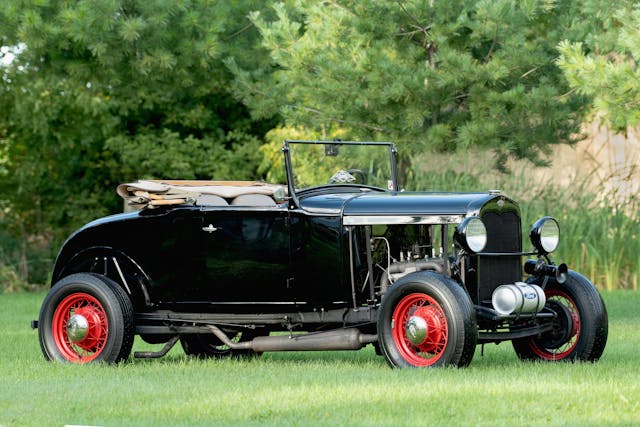
Of course, grandpa had to test his machine in competition, and for the Southern Californians who led the charge, the venue of choice was Muroc Dry Lake, now part of Edwards Air Force Base. Situated in Antelope Valley, just 100 miles north of Los Angeles, it was close enough for a day trip, even in a modified car. At Muroc, the expansive and sunbaked lakebed provided ample room for acceleration, and the young daredevils pushed their modified machines to speeds that Henry Ford had never intended.
Most of the competition results weren’t recorded. At the time, no one suspected we might be interested in learning more about their speed contests almost a century later. But there are records of a few events, including one held in 1931. At that meet, the winner was Ike Trone driving a 1929 Model A Roadster. Trone’s Ford four-cylinder had been fitted with a Riley cylinder head, dual carbs, and various other goodies, supplied by nascent SoCal speed shops, some of which would eventually become part of the huge California automotive performance industry.
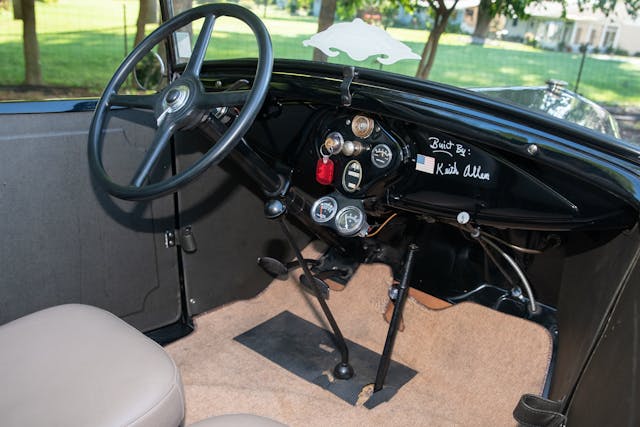
Palazzolo might never have owned a Model A gow job were it not for his long-time friends, Keith and Judy Allen. The Allens are Model A aficionados, senior citizens, and restoration experts. They’ve repaired and refurbished many a stock Model A for car owners across the country. In fact, one of their Model A coupes, a rusty unrestored survivor, was once displayed at Hagerty headquarters in Traverse City, Michigan. Devotees of traditional Ford performance, the Allens have hopped up early Fords to varying degrees, ranging from slightly warmed over to hot as heck. While much of their work has been for customers, they have also built several cars to satisfy their own Model A cravings, including a stripped down, hopped-up gow job that they cobbled together about 14 years ago.
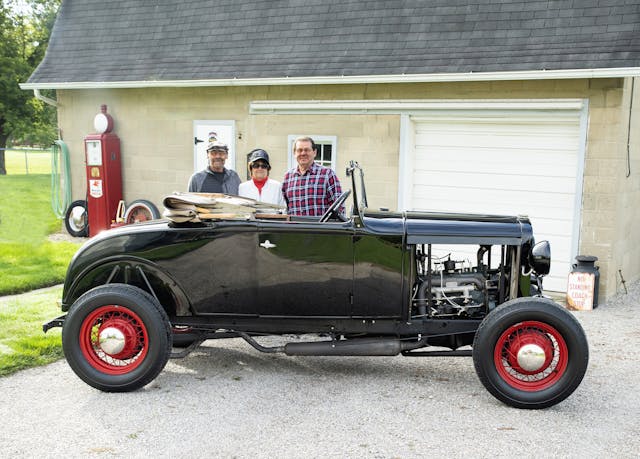
The Allens, with an almost obsessive love of the Model A, would never butcher a survivor car, so for the gow-job build they picked up parts where they could—here, there, and everywhere. Knowing the Model A community very well, they were able to locate pristine Model A body parts in the Irish Hills area of Michigan. A sheetmetal expert who specializes in prewar Fords assembled the panels using original Model A rivets.
A chassis was purchased from another supplier of Model A hardware and was fitted with rebuilt original parts, including brakes, steering, and drivetrain. Judy Allen scoured swap meets, picking up parts here and there. The transmission and rear end were rebuilt using stock Model A parts. An old engine that had seen many miles of service was mildly modified and installed in the chassis.
Keith and Judy Allen drove the assembled car for a while, occasionally pushing it to its limits, and its old engine predictably gave up the ghost. That opened the door for a fully rebuilt, more extensively modified engine, or as they were called back in the day, a “banger.”
Allen’s Model A experience had taught him that pistons from a 327 cubic-inch Chevy V-8 would work nicely in Model A cylinders, once overbored to 4 inches. That yielded a displacement of approximately 216 cubic inches. Aftermarket Model A pistons are available for a 4-inch bore, but used Chevy pistons are less expensive and lighter. An overbore increases the compression ratio, and to boost it further, the cylinder head was milled. A camshaft with a bit more lift and duration was installed, along with stainless steel valves. The stock intake manifold with its single updraft carburetor gave way to two Zenith carbs on a Vortex manifold. To enhance the engine’s high-rpm capability, Allen machined 13 pounds off the flywheel and installed a later-model Ford clutch and pressure plate. The vast majority of the parts that went into the engine and drivetrain would have been available to a 1930s enthusiast building a gow job.
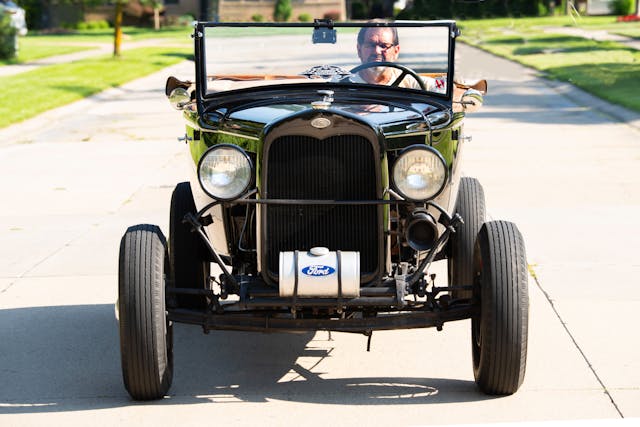
Palazzolo and the Allens have been friends for many years, so it wasn’t long before he saw the roadster and fell in love. The Allens were reluctant to part with the car but their friend was persistent, so they agreed to sell him the car—with stipulations. It could never be equipped with a V-8 engine and no changes to its configuration could be made without the approval of the Allens. Although Palazzolo had no intention of modifying this very special car, he understood why his friends wanted to safeguard their baby.
With the Model A tucked away in his garage, Palazzolo made a few allowable modifications. First, he revamped the interior, replacing the Model A bench seat with what we would call bucket seats from a Ford Tudor. Back in the day, they were called “jump seats,” because moving from one seat to the other required a jump of sorts. He also added a folding canvas top, an accessory considered unnecessary by dry-lake racers, but a nice addition for a Michigander who might encounter nasty weather on the road.
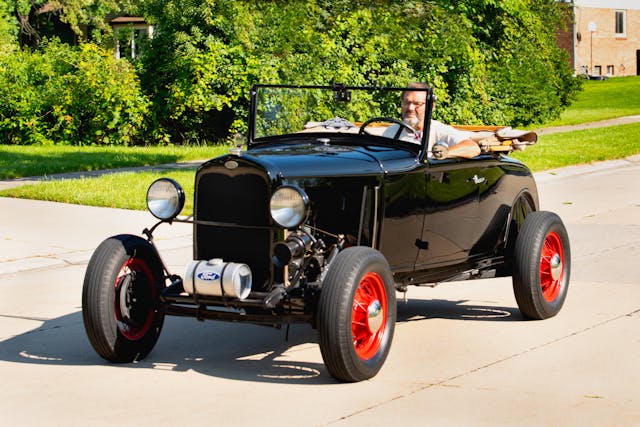
Like many of us who are very fond of an automobile, Palazzolo drives his Model A with caution, but he has occasionally had it over 70 mph on those narrow bias-ply tires. That can get exciting given the way those tires squirm, but that’s not the kind of excitement he enjoys. Both he and Allen think the car is probably capable of 80 mph. That would be downright thrilling. They know the dry-lake racers of almost a century ago would approve.

***
Check out the Hagerty Media homepage so you don’t miss a single story, or better yet, bookmark it. To get our best stories delivered right to your inbox, subscribe to our newsletters.
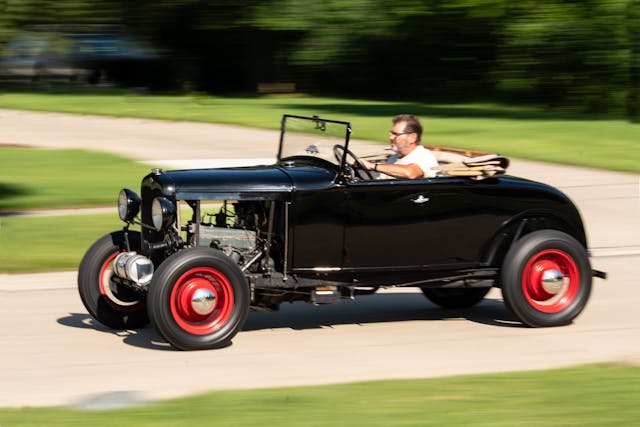
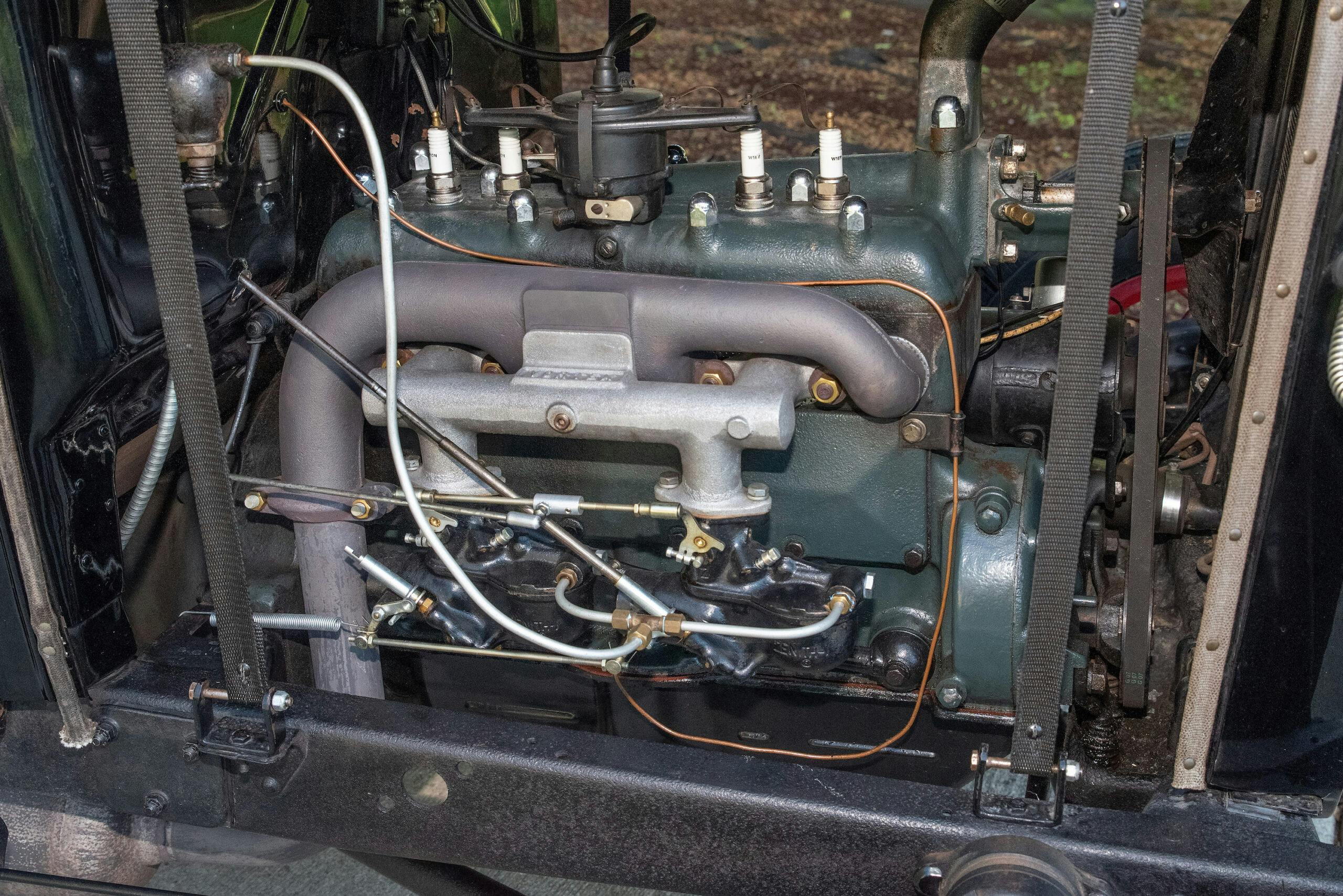
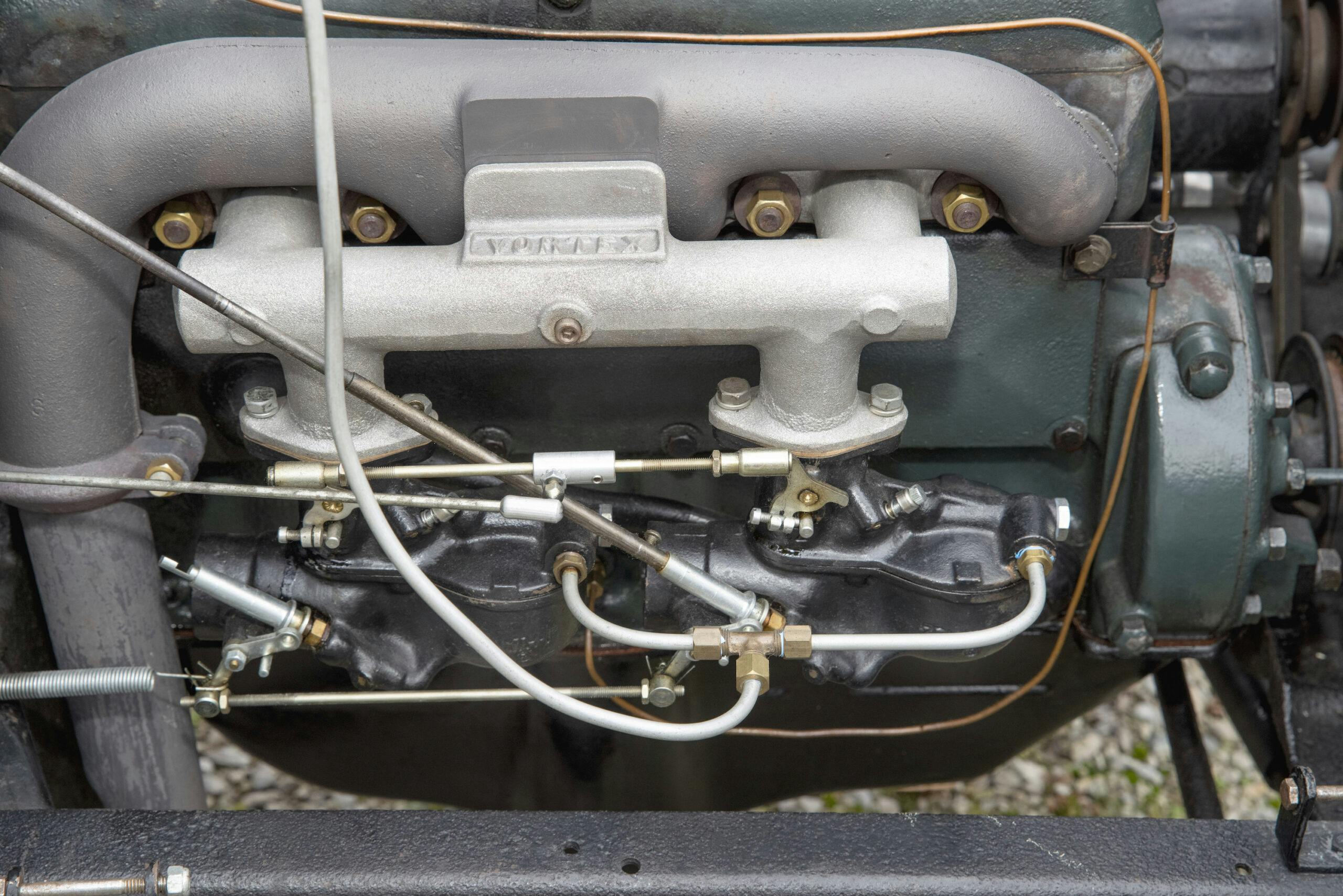


I learned something new today. The first thing I saw in the teaser photo was an actual Ford engine in a Model A… I knew this had to be something different. It does get a bit repetitive to see old Fords at car shows, and every single one of them has a SBC in it
Although it’s a Ford engine with SBC pistons in it… 🤔
Good point
Hagerty never fails to amaze me ….they never have their facts straight…Hagerty needs to conduct an audit of their information before posting…perhaps a new editor? Every article ive read by Hagerty is full of misinformation…wake up Hagerty!
Steady. Often they err, but not always.
While we all have seen errors in articles from time to time, I applaud the Hagerty editors for making corrections based on feedback in comments, and they will often respond to the call to correction in the comments.
To that end, rather than spout off in absolutists terms that the “never” are correct and “every” article is wrong, how about providing examples specific to this article of what the writer has wrong, and how you know your information is correct, so that they can adjust the article (if your information is in fact correct) and so the community in general can be uplifted through shared knowledge. That would be much better than unspecific general attacks.
If you hate their work so much (and it is valueless to you due to being wrong), and you have no interest in helping to improve it, then why the heck are you even here?
“Never” have facts straight? “Every” article full of misinformation but no examples cited? I was going to suggest you put your name in the hat for new editor but changed my mind.
“Everybody” knows that you should not use superlatives indiscriminately – it “always” comes back to bite you!
I nominate Tinkrah’s suggestion (the one he refrained from actually making while actually making) as the comment-of-the-day. 👍
Hagerty may not have all of their facts straight, but then again, there are a lot of oldsters that can do things the youngsters discount as impossible. NOT having to see another small block Chevy is FANTASTIC!!!!
No kidding.
Thank for one more entertaining article.
Timely article for me. I just acquired a Model A driving chassis that the previous owner took the body off to build a hot rod. I plan to build my own speedster by making a firewall and mounting seats and a gas tank. I will proudly announce it is a GOW job when someone asks what it is.
“Gow Job”? To paraphrase Tim the Toolman (“How do you spell that?”), just how do you pronounce “Gow”?
Like “Go”?
OMG if so then “Go Job” sounds remotely obscene! 😉
I don’t want to go up to someone who may think I said something else when I say “I really like your Go Job”.
I guess you don’t know how to pronounce COW either?
Maybe the W is silent – like K in know or H in either 😉
Jim, do you know for sure there are not two pronunciations of GOW, like BOW???
Milling the head, that is, making the compression chamber smaller with an unchanged stroke, will increase the compression. Increasing the bore size will increase the volume. Can someone explain how increasing the bore size will increase compression?
It depends on how much you “mil” the head.
Compression ratio is determined by cylinder volume/combustion chamber volume. Increasing the bore size increases cylinder volume, thus the compression ratio is increased. For example, if combustion chamber volume is 100cc and cylinder volume at bottom dead center of the stroke is 1000cc, the compression ratio is 10:1. Bore the cylinder to a size that increases its volume to 1050cc and the compression ratio increases to 10.5:1
Never heard the term “gow job” before. Interesting story and cool car.
Another explanation of “gow” (1915, “opium,” from Cantonese yao-kao “opium,” literally “drug-sap;” used as such by Raymond Chandler, etc.) comes from Etymonline. That entry mentions “gow job” as a word for a suped up car, but unfortunately garbles the time line.
Yes, that is my family name!
Thanks, Paul, for a good look at nascent rodding. This is especially interesting for those of us tired of ubiquitous SBC 350/Turbo HydraMatic “retro rod” Frankencars. Nice to see original, authentic cars retaining their souls — their original drive trains– albeit with period speed equipment, tweaks of yore, these showing knowledge and appreciation beyond the ignorant wanting an “old timey” look.
AMEN, SU8overdrive! So many restorable cars have been butchered with engines that barely run smooth enough at low RPM to be streetable. Good cars handle, as well as go fast.
My father-in-law has willed me a 31′ Ford Model A. It was used in local parades back in the 80’s and to this date is very much original complete and parked in a barn. I will admit my intent after he passed was to make him roll in the grave by palliating the original drivetrain and stuffing a Chevy 350/TH350 drive train in it… But this article has swayed my opinion of making something less “common.” Working part time at a machine shop we have many sets of old stock 327 pistons that sadly have corroded, but I bet I can get a set of 4 from 8. I like the norm, but love enthusiastic builds… more so when they have a purpose for being build, like rare history.
I have a Miller-Schofield engine that would be a great basis for a “gow job” or “banger hot-rod,” I just need to find a nice Model A. Maybe a coupe? Chopped highboy?
Actually, it was cocaine that was fed to horses to boost performance. “Coke’s for horses, not for men. Doc says it’ll kill me but he won’t say when.”
Not necessarily: see https://aaep.org/sites/default/files/issues/proceedings-07proceedings-z9100107000240.pdf
“The usefulness of opioids as single-agent analgesics in horses has been tempered by the propensity for opioids to produce excitement when administered alone in non-painful horses.”
Nice A model. Why is the muffler and tail pipe so low?
Perhaps to get it down past the two updraft carbs?